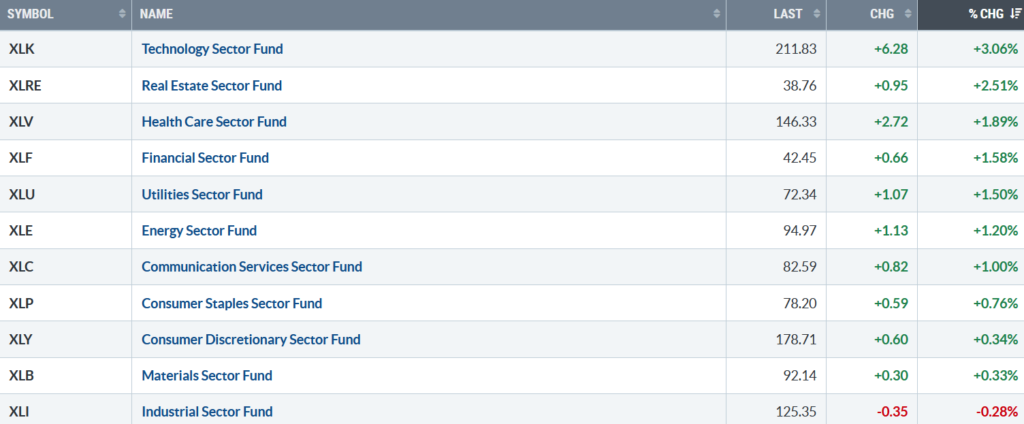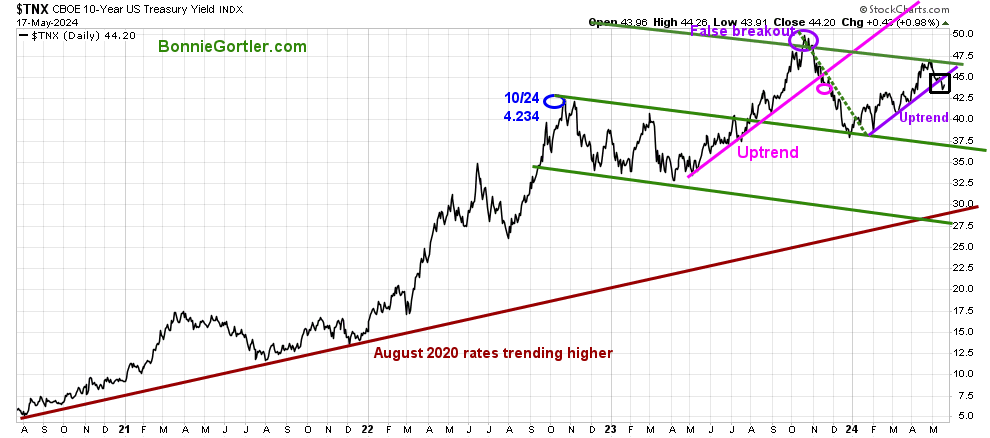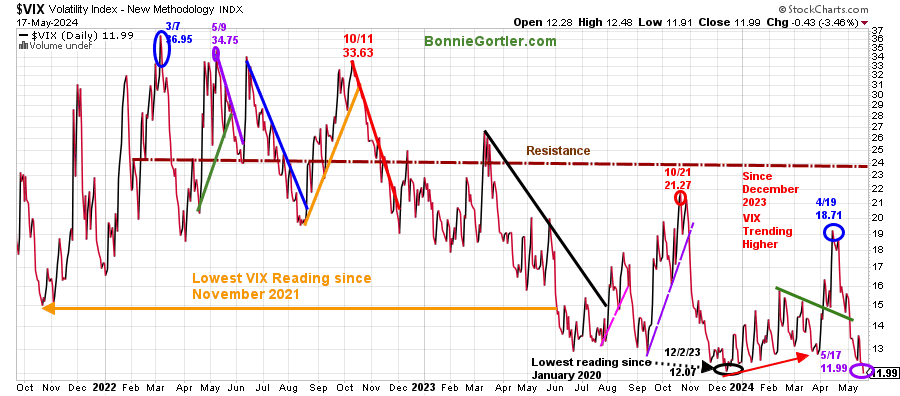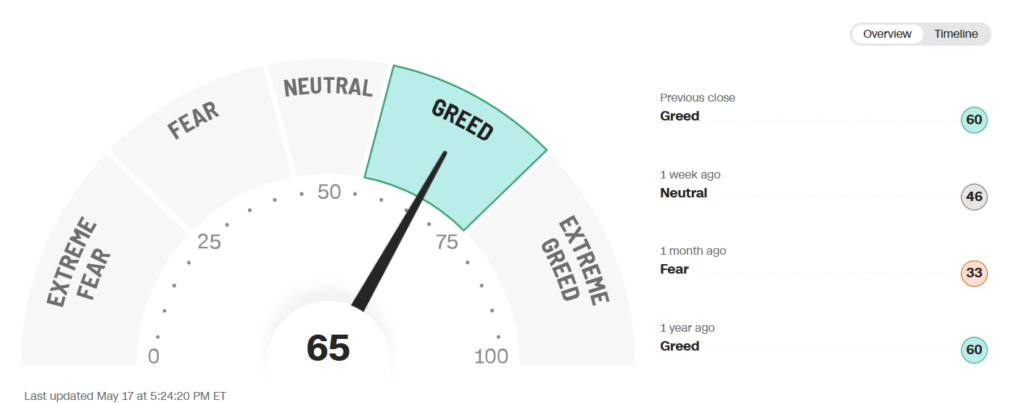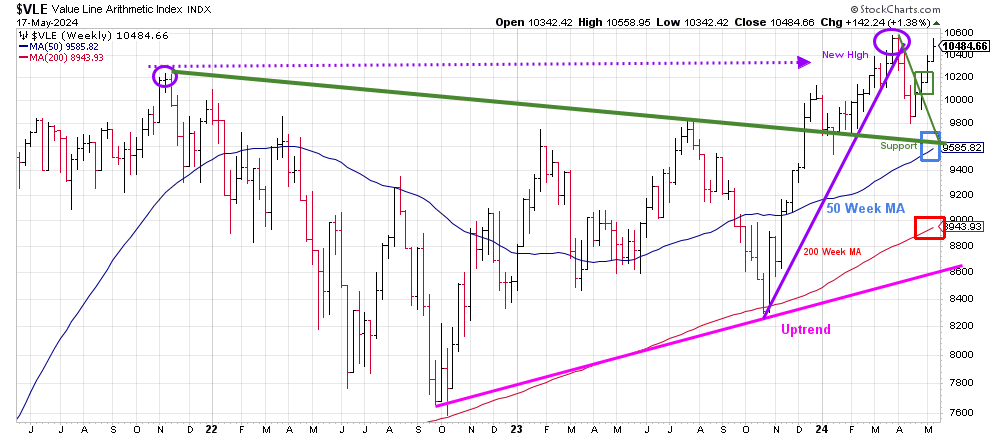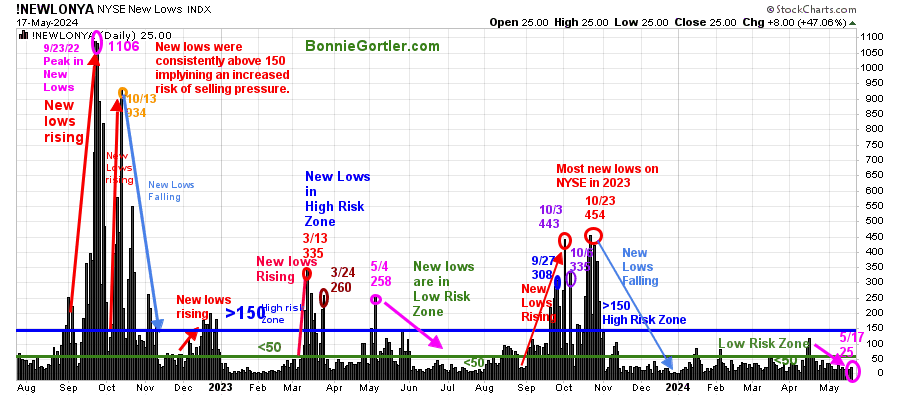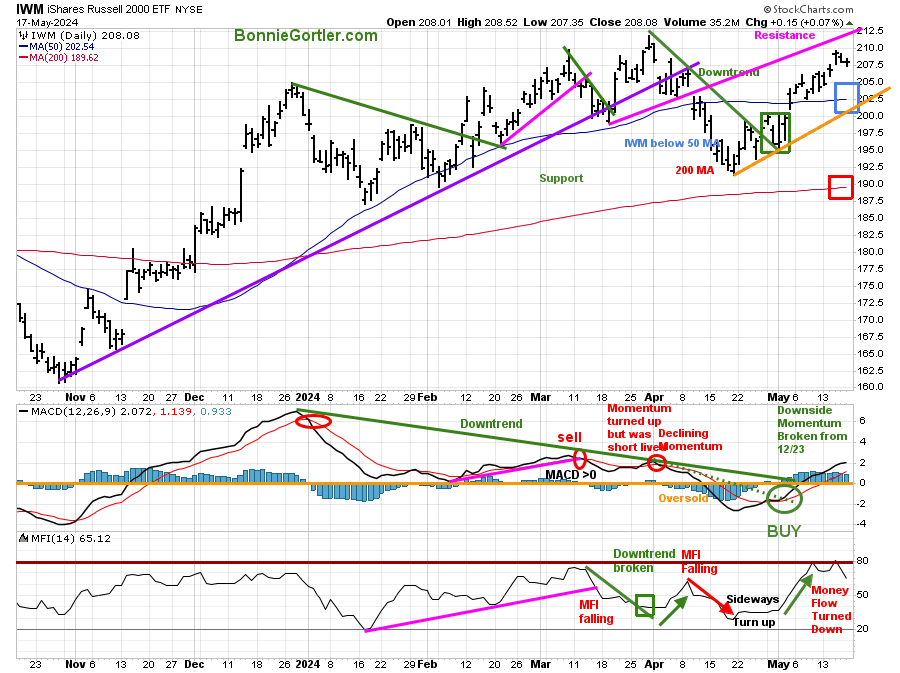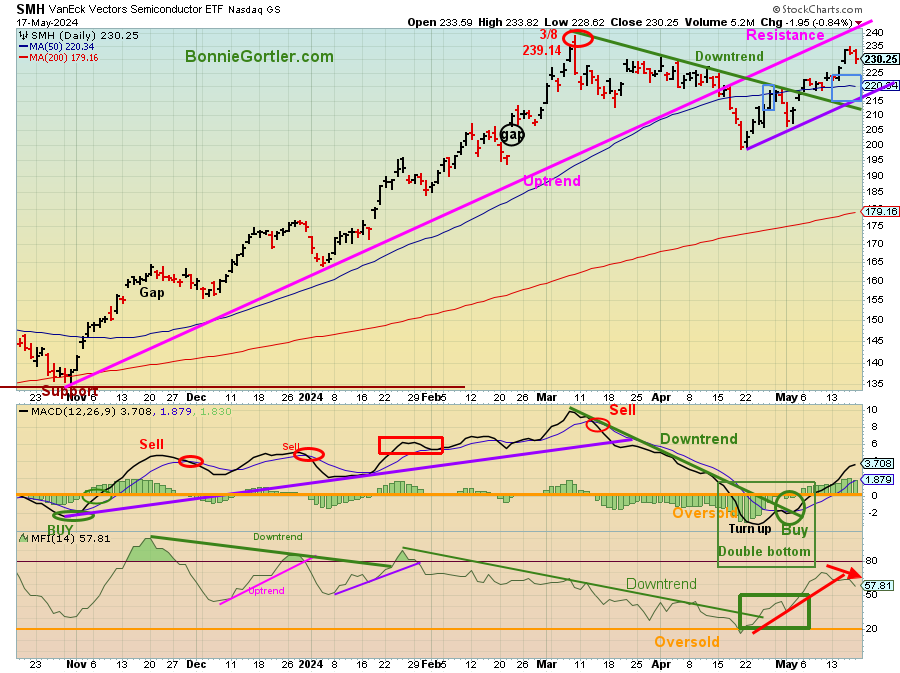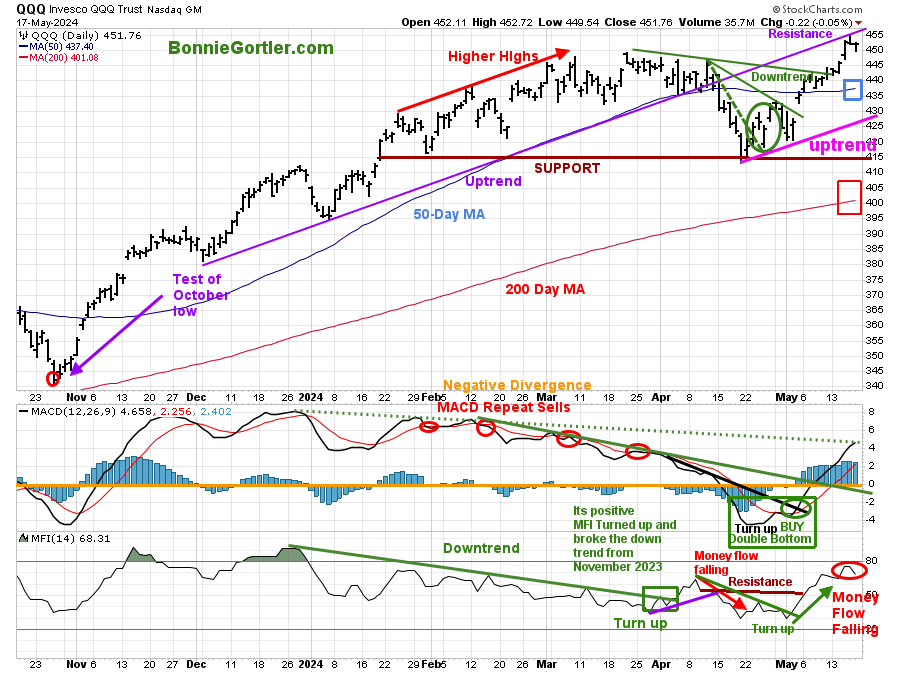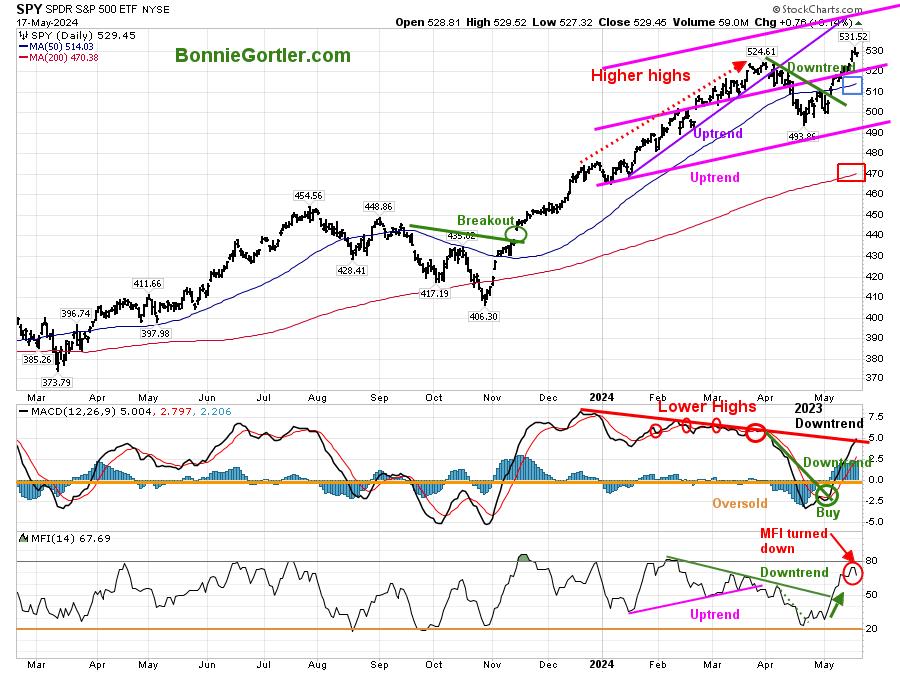Bonnie’s Market Update 5/17/24
Bonnie’s Market Update 5/17/24
The uptrend in May continued with solid gains last week. Ten of the eleven S&P SPDR sectors finished higher. Technology (XLK) and Real Estate (XLRE) were the strongest, while Materials (XLB) and Industrial (XLI) were the weakest. The SPDR S&P 500 ETF Trust (SPY) was up +1.65%.
S&P SPDR Sector ETFs Performance Summary 5/10/24-5/17/24
Source: Stockcharts.com
Figure 2: Bonnie’s ETFs Watch List Performance Summary 5/10/24-5/17/24
Source: Stockcharts.com
Last week, China, Semiconductors, and Emerging Markets were strong, outperforming the S&P 500. Hi Yield Bonds rose but with no zest, while Transportation was negative.
Figure 3: UST 10YR Bond Yields Daily
Source: Stockcharts.com
The 10-year U.S. Treasury fell last week, closing at 4.426%, near the lowest level since April, breaking the January 2024 uptrend (purple line). Yields continuing lower would likely be positive for U.S. Equities. On the other hand, yields rising and closing above 4.75% could fuel selling pressure in U.S. Equities.
Figure 4: CBOE Volatility Index VIX
Source: Stockcharts.com
The CBOE Volatility Index (VIX), a measure of fear, traded above 20.00 for most of 2022, with a high at 36.95 on 3/7 (left blue circle), which did not get violated in 2023.
VIX had a short-term peak at 18.71 on 4/19/24 and continued to decline, closing at 11.99 (purple circle), the lowest reading since 12/2/23 and its first close below 12.00 since 2019. Intraday volatility will likely stay contained as long as VIX is below 16.00
The major market averages all rose last week. The Dow was up +1.24%, rising for the fifth straight week, the S&P 500 was up +1.54%, and the Nasdaq was up +2.11%, both positive for their fourth week. The Russell 2000 Index outperformed all, up +1.74%.
Are you interested in learning more about investing in the stock market? Discover how to implement a powerful wealth-building mindset and simple, reliable strategies to help you grow your wealth in my eCourse Wealth Through Investing Made Simple. Learn more here.
Figure 5: Fear & Greed Index
Source: CNN.com
Investor sentiment based on the Fear and Greed Index (a contrarian index) measures the market’s mood. The Fear and Greed Index is no longer showing fear. It is now showing Greed. Risk is on the rise of a market pullback.
Figure 6: Weekly Value Line Arithmetic Average
Source: Stockcharts.com
The top chart is the weekly Chart of the Value Line Arithmetic Index ($VLE), which includes approximately 1700 stocks. The longer-term uptrend from October 2022 (pink line) remains.
VLE held support and turned up after breaking March (green line). VLE rose by +1.38%, closing at 10484.66, near its high for the week, and it remains above the rising 50-week MA (blue rectangle) and 200-week MA, which is bullish.
Support is at 10300, 9600, 8900, and 8600. Resistance is at 10600.
The odds of further upside in the short term will increase if VLE closes above the weekly high of 10558.95. On the other hand, a close below 10300 would be a short-term negative.
Market Breadth Continues to Improve
Weekly market breadth was positive on the New York Stock Exchange Index (NYSE) and for the Nasdaq. The NYSE had 1973 advances and 916 declines, with 464 new highs and 54 new lows. There were 2956 advances and 1627 declines on the Nasdaq, with 445 new highs and 228 new lows.
Do you want to understand more about charting? Learn more in the comfort of your home today with my Free 33-minute Training, Charting Strategies to Cut Risk and Trade with the Trend. Sign up here.
Figure 7: New York Stock Exchange (NYSE) New Lows
Source: Stockcharts.com
Watching New Lows on the New York Stock Exchange is a simple technical tool that helps increase awareness of the direction of an immediate trend.
For most of 2022, new lows warned of a potential sharp pullback, high volatility, and “panic selling,” closing above 150. The peak reading of New Lows in 2022 was on 9/23 at 1106, not exceeded in 2023.
In 2024, New Lows have stayed below 150, and a good part of the year below 50, a sign of a healthy market.
Last week, New Lows on the NYSE closed at 25 (pink circle), in the lowest risk zone. If new lows remain between 25 and 50, it would be positive in the short term. On the other hand, an increase above 150 would be a warning sign of a market correction.
Learn more about the significance of New Lows in my book, Journey to Wealth, published on Amazon. If you would like a preview, get a free chapter here.
Small Caps Rising Is Favorable
Figure 8: Daily iShares Russell 2000 (IWM) Price (Top) and 12-26-9 MACD (Middle and Money Flow (Bottom)
Source: Stockcharts.com
The top Chart is the daily iShares Russell 2000 Index ETF (IWM), the benchmark for small-cap stocks, with a 50-Day Moving Average (MA) (blue rectangle) and 200-Day Moving Average (MA) (red rectangle) that traders watch and use to define trends.
IWM peaked in March after forming a bearish pattern of lower highs, falling below the 50-day MA in early April but holding above the 200-day MA, a key area. IWM then reversed in May.
IWM gained +1.85%, slightly stronger than the S&P 500 last week, remaining in an uptrend (orange line) and above the 50-day and 200-day MA, a positive sign for the near term.
Support is at 205.00, 202.50, 200.00, and 190.00. Resistance is at 212.50 and 214.50.
MACD (middle chart) is on a buy, above 0, and no longer shows the downside momentum (green line), as in early 2024.
Money flow (lower chart) moved sideways in mid-April, turning up in May, but is trending down, which bears watching to see if it continues or starts to rise.
Double Bottom Formation in Momentum For Semiconductors and Technology was Successful
Figure 9: Daily Semiconductors (SMH) (Top) and 12-26-9 MACD (Middle) and Money Flow (Bottom)
Source: Stockcharts.com
The top chart shows the Daily Semiconductors (SMH) ETF, concentrated mainly in US-based Mega-Cap Semiconductor companies. SMH tends to be a lead indicator for the market when investors are willing to take on increased risk, and the opposite is true when the market is falling.
The Semiconductor ETF (SMH) peaked on 3/8 at 239.14. SMH trended lower in early April, but in May, it reversed higher, breaking the March downtrend (green line).
SMH gained +3.11%, closing at 230.25, above the 50-day Moving Averages (blue rectangle). It is disturbing that on Friday, the rally stalled without making a new high and closed under resistance (pink line) and below Friday’s open.
Support is 227.00, 225.00, 220.00, 215.00, 200.00, and 180.00. Resistance is at 235.00, 240.00, and 245.00.
MACD (middle chart) remains on its buy from below 0, rising from a favorable double-bottom formation but with less momentum than earlier in the year.
Money flow (lower chart) rose after breaking the January downtrend, but it is falling, warning that investors may be starting to move out of Semiconductors.
Figure 10: Daily Invesco QQQ Trust (QQQ) Price (Top) and 12-26-9 MACD (Bottom) ) and Money Flow (Bottom)
Source: Stockcharts.com
The Chart shows the daily Invesco QQQ, an exchange-traded fund based on the Nasdaq 100 Index. QQQ made a low in October 2023 (red circle), followed by the start of an uptrend through April 2024, and then broken.
Nasdaq 100 (QQQ) rose last week, up +2.19%, breaking the downtrend (green line) and closing at 451.76, above the 50-day MA (blue rectangle) and the 200-day MA. Support is at 445.00, 437.00, 430.00, 415.00, and 400.00. Resistance is at 453.00 and 455.00.
The bottom chart, MACD (12, 26, 9), remains on a buy, above 0, rising after a favorable double bottom formation, including breaking the downtrend from March (black line), February (green line), and now close to breaking the December downtrend (green dotted line).
Money flow (lower chart) turned up in April, breaking the downtrend, which was a positive sign but is now falling, a short-term negative.
In Sum:
QQQ has had a solid rally from an oversold condition, making a new all-time high. I would like to see QQQ close two days above 455.00 and money flow to turn up to imply further gains in the short term.
Do you want more knowledge about the stock market? Learn how to implement a powerful wealth-building mindset and simple, reliable strategies to help you grow your wealth. Check out my eCourse Wealth Through Investing Made Simple Here.
Figure 11: The S&P 500 Index (SPY) Daily (Top) and 12-26-9 MACD (Middle) and Money Flow (Bottom)
Source: Stockcharts.com
The SPY April downtrend (green line) broke in early May, shifting the short-term trend to up.
SPY closed up +1.65% at 529.45, closing near last week’s high and above the 50-day Moving Average (blue rectangle) and remains above the 200-day Moving Average (red rectangle).
Support is at 525.00, 520.00, 514.00, 490.00 and 470.00. Resistance is at 532.00, with an upside potential objective of 550.00.
MACD (middle chart) remains on a buy above 0, rising, already breaking the downtrend from March, and now close to breaking the December 2023 downtrend (red).
Money Flow (bottom chart) accelerated higher after breaking the February downtrend (green line) and peaked in the short term.
Two closes above 531.52 would imply the SPY is moving towards the 550.00 short-term objective.
Summing Up.
The rally is broadening. Market breadth is improving, with more and more stocks making new highs. The major averages continued higher as the Dow Jones Industrials hit 40,000. The major averages are on their way to showing gains for the sixth time out of the past seven months. The tape action favors the bulls.
Remember to manage your risk, and your wealth will grow.
Let’s talk about investing together. You are invited to schedule your Free 30-minute consultation here or by emailing me at Bonnie@BonnieGortler.com. I would love to schedule a call and connect with you.
Disclaimer: Although the information is made with a sincere effort for accuracy, it is not guaranteed that the information provided is a statement of fact. Nor can we guarantee the results of following any of the recommendations made herein. Readers are encouraged to meet with their own advisors to consider the suitability of investments for their own particular situations and for determination of their own risk levels. Past performance does not guarantee any future results.


